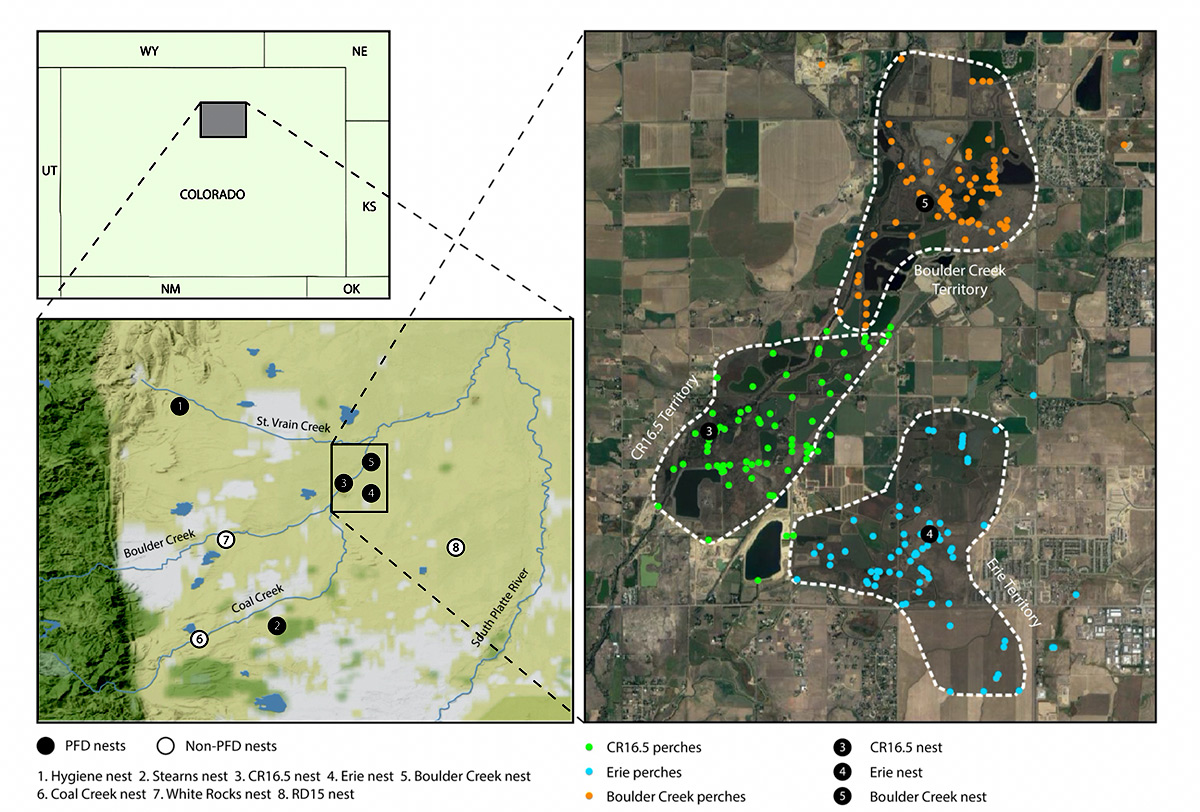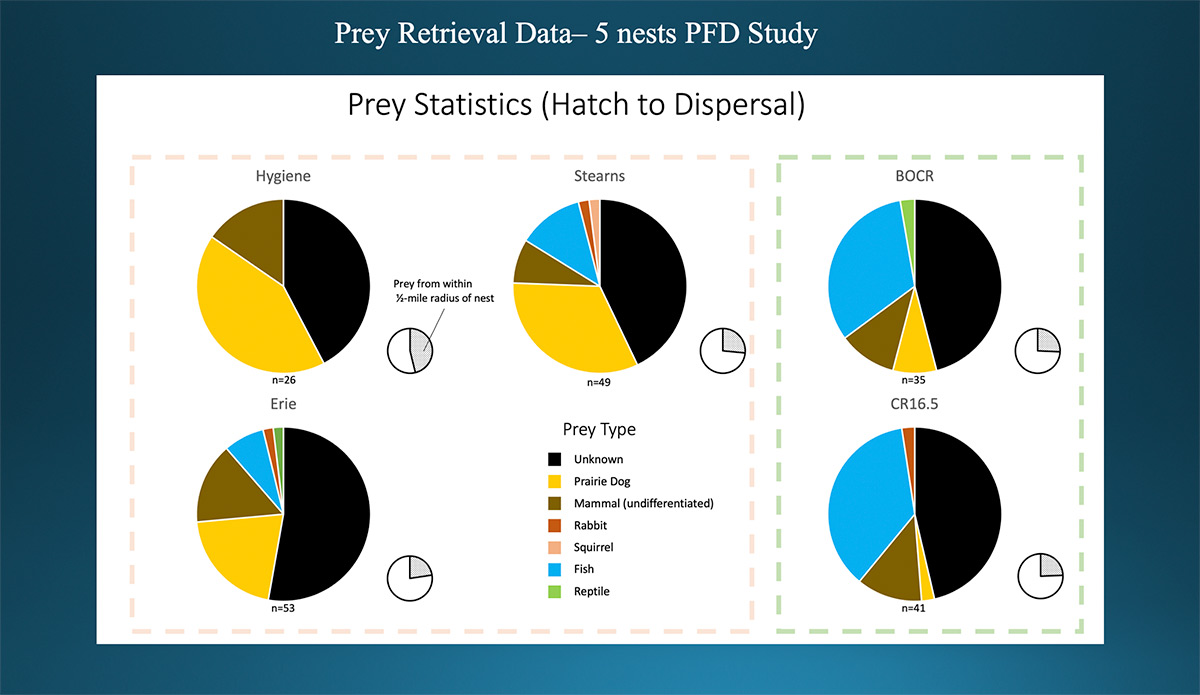Colorado Front Range Bald Eagle Nest Territories and Prey
Bald Eagle Nests in the Northern Colorado Front Range (NCFR)
November 4, 2022
Nest territories are essentially equivalent to what are called core-use areas, which are areas used more frequently than any others by wildlife. These areas contain homesites, refuges, and the most dependable food sources. Since core-use areas for bald eagles are commonly calculated based on usage pattern for a much larger home range—well beyond visual tracking—telemetry is commonly used. However, the equivalence of core-use areas for nesting eagles can also be reliably determined by careful field studies that integrate geospatial data for perch locations and defended distances against other eagles. These core-use-equivalent areas are defined our studies as nest-territories, and here we’ll discuss how we map them and what they tell us about our territorial bald eagles.
Due largely to its dry climate, there are still only about 246 occupied Bald Eagle nests in Colorado (R. Conrey, CPW, written communication, 2022). In contrast, more verdant and resource-rich areas like Florida (>2,569 active nests), Chesapeake Bay (2,474 active nests); Louisiana (> 2,978 active nests); Maine (1,627); and Oregon (1,703), host 7 to 12 times the number of Colorado nests (U.S. Fish and Wildlife Service, 2020).
Bald eagle nests in the northern Colorado Front Range (NCFR) are generally located proximal to stream corridors with adjacent ponds and wetlands. Many of these ponds originated from gravel quarry mining that commenced in the NCFR during the 1950s and 1960s (Wilburn and Langer, 2000). Subsequent to mining, the quarry pits filled with groundwater and many now host an abundance of fish. Due to the steep decline of bald eagle populations due to DDT through much of North America after the early 1940s (Bowerman et al. 1995; Grier 1982; Stinson et al. 2007), bald eagles were rarely noted in the Front Range until the early 1980s (Henderson 1909; Jones 2009). The first documented bald eagle nest in the NCFR was established at Barr Lake in 1986 (Colorado Parks and Wildlife 2020), followed by Standley Lake in 1993 (Bird Conservancy of the Rockies 1993).
Detailed Bald Eagle Nest Studies in the Northern Colorado Front Range by FRNBES
Front Range Nesting Bald Eagle Studies (FRNBES) has conducted intensive field studies on 8 bald eagle nests sites in nearly a 1,000 km2 area in the NCFR. Figure 1 shows the locations of 8 of the field studied nests, and the circles in black represent 5 nests we have studied since 2017 for our post-fledging dependence (PFD) studies. Since 2015 FRNBES has amassed more than 6,500 hours conducting quantitative field studies on these 8 nest sites.
For the purposes of FRNBES studies, nest territories, as shown in figure 1, are defined as 1) the area encompassed by a line tightly fit around all mapped perches, and 2) the outer boundary is limited to a 2 km radius from the nest, which represents the near-maximum defended distance against other bald eagles (D. Bove and T. Kuhn unpubl. data). During the past 6 years (2016-2022), only 4 new nests have been added in the 1,000 km2 FRNBES study area, which now has a current total of 15 nests. Nest territory size for 8 nests in the FRNBES study area averages 3.7 km2 and ranges from 2.4 to 4.8 km2. To put this in more relatable terms, the 3.7 km2 average nest territory is equivalent to that of nearly 723 NFL football fields arranged sided by side.

Figure 1. Locations of 8 of the most intensively studied nests in the field by FRNBES, and the circles in black are the 5 nests we have studied since 2017 for our post-fledging dependence (PFD) studies. Near-nest territories for 3 of the 5 PFD study nests are shown on the right.
Data extrapolated from nest studies in and around the 1,000 km2 FRNBES study area indicate that adult territorial bald eagles in the northern Colorado Front Range (NCFR) are non-migratory and remain in their near-nest territories year-round (D. Bove and T. Kuhn unpubl. data). Data from the 5 PFD study nests (Fig. 1) documents that there is at least one territorial adult visible during 64.1 – 81.5% of our survey time. There are only a few exceptions: 1) brief forays outside of the near-nest territory lasting less than a day which may be for hunting purposes and are observed at all nests and 2) summer hiatuses observed at two of our nests ranging from one week to almost two months typically in June, July and/or August.
Near-nest territories in the FRNBES study vary significantly in available resources, which correlates with observed differences in prey sources: two near-nest territories had high (24.1-25.9%) water coverage, and fish made up a correspondingly large percentage of observed prey consumed (32.4-36.6% fish) compared to the two nests with the lowest water coverage (0.9-2.6% water coverage; 7.6-12.2% fish). Black-tailed prairie dog (Cynomys ludovicianus) colonies are common in the upland portions of the study area, covering 4.4-27.4% of near-nest territories, and were the most-frequently identified prey item at three out of five nests for which prey data was gathered. Despite abundant waterfowl present near several nests, waterfowl did not make up a significant portion of observed prey at any nest.
Prey retrieval statistics from 5 of the PFD study nests are presented in figure 2. Our more or less “upland” nests are on the left, and nests adjacent to waterways on the right in green. As you can see in figure 2, prairie dogs comprise the dominant known prey source at all 3 nests, as shown on the left. Nearly 25 to 50% of the prey at the upland nests were derived from ½ mile of the nest. Fish are the primary prey derived at the two near-water nests, once again attesting to the near source importance of prey in both environments. Nearly 25% of the documented prey deliveries at nests adjacent ponds with fish were from ½ mile of the nests.

Figure 2. Prey retrieval statistics for territorial adult bald eagles from the 5 nests for PFD study.
Literature Cited
- Bird Conservancy of the Rockies. 1993. Home range and critical areas for bald eagles at Standley Lake. Unpublished Report.
- Bowerman, W.W., Giesy, J.P., Best, D.A., Kramer, V.J. 1995. A review of factors affecting productivity of bald eagles in the Great Lakes region: implications for recovery. Environmental Heath Perspectives 103: 51-59.
- Colorado Parks and Wildlife 2020. Recommended buffer zones for seasonal restrictions for Colorado raptors.
- Grier, J.W. 1982. Ban of DDT and subsequent recovery of reproduction in Bald Eagles. Science 218:1232–1235.
- Henderson, J. 1908. An annotated list of the birds of Boulder County, Colorado. University of Colorado Studies 6:220.
- Jones, S.R. 2009. Bald eagle nesting activity in Boulder County. Boulder County Nature Association, unpublished report. 4p.
- Stinson, D.W., Watson, J.W. and McAllister, K.R. 2007. Washington State status report for the bald eagle. Washington Department of Fish and Wildlife, Wildlife Program. 86p
- Wilburn, D. R. and Langer, W.H. 2000. Preliminary report on aggregate use and permitting along the Colorado Front Range. U.S Geological Survey Open-File Report 00-258. 21p.
- U.S. Fish and Wildlife Service. 2020. Final Report: Bald Eagle Population Size: 2020 Update. U.S. Fish and Wildlife Service, Division of Migratory Bird Management, Washington, D.C. U.S.A.
